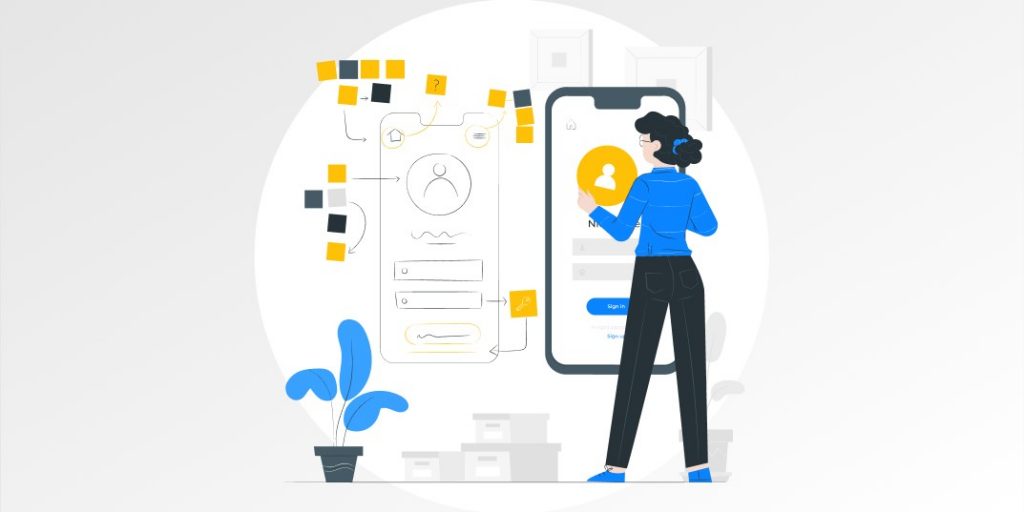The world’s first prototype of a smartphone was introduced by the IBM company in the early 1990s. Since then, the influence of mobile devices has grown dramatically. Mobile dev teams are releasing thousands of applications every day, thus providing potential users with new digital experiences. In this article, we will walk you through the mobile app development process step by step.
written by:
Anastasia Borodinets
The world’s first prototype of a smartphone was introduced by the IBM company in the early 1990s. Since then, the influence of mobile devices has grown dramatically. Mobile dev teams are releasing thousands of applications every day, thus providing potential users with new digital experiences. In this article, we will walk you through the mobile app development process step by step.
According to the latest report by Statista, the number of app downloads reached 204 billion last year, bringing app owners more than $464 billion in revenue. Mobile applications are becoming one of the most effective ways of reaching out to potential customers. So it’s no surprise that companies of various sizes and industries are willing to introduce their own applications to the global market. While most of the enterprises realize what advantages they get with apps, not so many people know how they are actually made. Let’s have a closer look at every step of the app development process.
Idea
Before we proceed to actual development, everything always starts with an idea. Even though some of these ideas might sound brilliant, not all of them address key challenges and objectives a target user has. That’s why every single idea is evaluated carefully and discussed with the client to make sure, in the end, they get exactly what they need. At this stage, we check whether the idea is feasible and if it responds to the end user’s key pain points. The communication is crucial at this point, since our main goal, as a mobile app development service provider, is to get a clear understanding of the client’s idea.
Strategy
As a part of the process for mobile app development, it’s important to identify the strategy for turning all of the initial ideas into a well-functioning product.
Additionally, both marketing and monetization policies can be discussed with the client to clarify how the app will be promoted before and after the launch and how it will bring revenue to the business.
Analysis & Planning
At this stage, business analysts and tech experts identify use cases and key app functionality. Depending on the decision made during the previous steps of the mobile app development process, the dev team will see what skills are required for this project and what specialists will be working on it. Whether you need separate apps for different platforms or want to go for a cross-platform solution, you’ll be provided with the developers with the relevant experience. When developing a mobile app, the process can take up to several months, so make sure to indicate deadlines.
Prototyping
This is when your ideas start taking shape. Prototypes help clients to see and feel their solution before the actual app development process begins. They simulate both key functionalities and user experience. Prototyping starts with building wireframes that represent the visual structure of the future application. Later on, you get to plan the navigation and the overall look of your app including the design.
App Development
The agile development process includes everything from defining the tech stack to building APIs, as well as front-end and back-end development. This, without exaggeration, is probably the most important step in the mobile application development process. The more accurate dev teams are at this stage, the fewer errors they’ll need to fix in the future.
Quality Assurance
The quality assurance and app testing activities, ideally, should be conducted alongside the development stage to make sure that the app functions perfectly. QA specialists run the app on various devices and platforms (if needed) to identify any bugs and fix them before the official launch. This stage includes various types of testing, from functional and usability testing to security verification, and more.
Release
As soon as the quality and performance of the application are verified, it can be officially published on app stores. Before it gets released, the app should be given a name, a category, a description, and all the information required in accordance with the app store rules. Once published, the app’s page should be reviewed and verified.
Post-Launch & Ongoing Support
When your application goes live, it’s important to enable real-time analytics to keep track of its success. As soon as you start getting the first feedback, you’ll see whether your application requires new functionality to engage more users and enhance their experience. Besides that, if you want to stay on top of the competition, your apps should align with the latest trends and technologies and thus they require continuous updating.
Conclusion
Hopefully, the mobile app development process got more clear with our step-by-step guide. If you are looking for a high-performing feature-packed mobile solution for your business, reach out to experts at Qulix Systems. Whether you need a native application or want to introduce a cross-platform solution, we got you covered all the way.

Contacts
Feel free to get in touch with us! Use this contact form for an ASAP response.
Call us at +44 151 528 8015
E-mail us at request@qulix.com











